
The mimids are the New World family of passerine birds, Mimidae, that includes thrashers, mockingbirds, tremblers, and the New World catbirds. As their name suggests, these birds are notable for their vocalization, especially some species' remarkable ability to mimic a wide variety of birds and other sounds heard outdoors. They are commonly referred to as mimic thrushes but are not, in fact, thrushes.

Mockingbirds are a group of New World passerine birds from the family Mimidae. They are best known for the habit of some species mimicking the songs of other birds and the sounds of insects and amphibians, often loudly and in rapid succession and for being extremely territorial when raising hatchlings. Studies have shown the ability of some species to identify individual humans and treat them differently based on learned threat assessments.
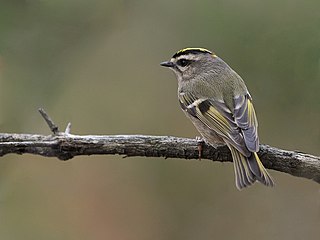
The golden-crowned kinglet is a very small songbird in the family Regulidae that lives throughout much of North America.
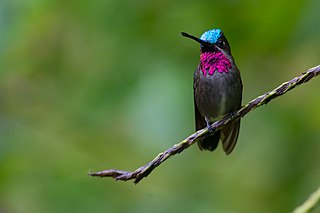
The long-billed starthroat is a species of hummingbird in the "mountain gems", tribe Lampornithini in subfamily Trochilinae. It is found in Mexico, Central America, Trinidad, and all but the four southernmost countries of South America.
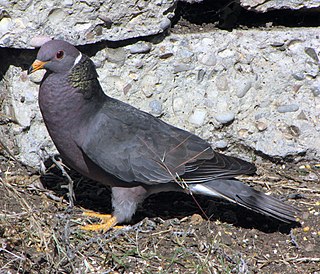
The band-tailed pigeon is a pigeon native to the Americas, and the largest pigeon native to North America. They are a native species throughout the Southwestern United States and Mexico, extending south to Peru.
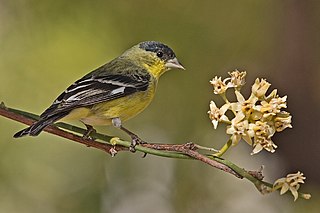
The lesser goldfinch is a small finch in the genus Spinus native to the Americas.

The long-billed hermit is a bird in the family Trochilidae, the hummingbirds. It is found from central Mexico south through Central America, Colombia and Ecuador into Peru.

The long-tailed hermit is a large hummingbird that is a resident breeder in Venezuela, the Guianas, and north-eastern Brazil. This species was formerly referred to as the eastern long-tailed hermit.
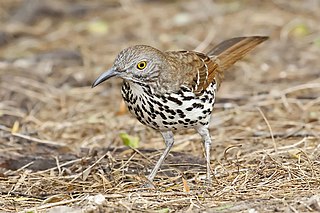
The long-billed thrasher is a medium-sized resident songbird of South Texas and eastern Mexico. It bears a strong resemblance to its close relative the brown thrasher in appearance, calls, and various other behaviors; however, the two species do not overlap in range except in the winter when the brown thrasher will temporarily reside in the northern range of the long-billed.

The black-eared wood quail is a bird species in the order Galliformes. Until recently, the species was thought to be part of the family Phasianidae however DNA-DNA hybridization results determined that black-eared wood quail are only distantly related to Old World quail. As a result, black-eared wood quail have been placed in the family Odontophoridae and more specifically, in the category of wood quail.
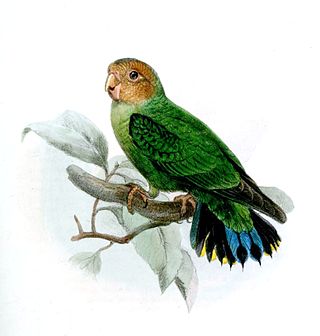
The buff-faced pygmy parrot is a very small green parrot found in subtropical or tropical moist lowland forest in New Britain and New Guinea.

The forest kingfisher, also known as Macleay's or the blue kingfisher, is a species of kingfisher in the subfamily Halcyoninae, also known as tree kingfishers. It is a predominantly blue and white bird. It is found in Indonesia, New Guinea and coastal eastern and Northern Australia. Like many other kingfishers, it hunts invertebrates, small frogs, and lizards.

The blue-and-white mockingbird is a species of bird in the family Mimidae. It is found in El Salvador, Guatemala, Honduras, and Mexico.

The azure-crested flycatcher or the blue-crested flycatcher, is a species of bird in the monarch flycatcher family Monarchidae. It is endemic to Fiji, where it is found on Taveuni.

The blue whistling thrush is a bird in the Old World flycatchers family Muscicapidae that is found in the mountains of Central Asia, South Asia, China and Southeast Asia. It is known for its loud human-like whistling song at dawn and dusk. The widely distributed populations show variations in size and plumage with several of them considered as subspecies. Like others in the genus, they feed on the ground, often along streams and in damp places foraging for snails, crabs, fruits and insects.
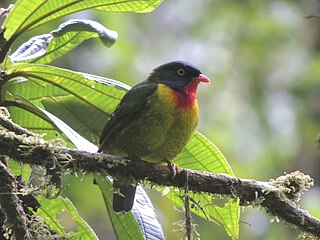
The scarlet-breasted fruiteater is a species of bird in the family Cotingidae. It is found in Bolivia, Ecuador, and Peru where its natural habitat is subtropical and tropical moist montane forests. Two subspecies are recognised though some researchers consider these should be regarded as distinct species. It is a plump green bird with a black head, the males having red throats and the females yellow. It is a relatively common species with a wide range, and the International Union for Conservation of Nature has rated its conservation status as being "least concern".

The large-billed scrubwren is a passerine bird in the family Acanthizidae, endemic to eastern Australia. It is found in denser undergrowth in temperate forest, subtropical or tropical moist lowland forest, and subtropical or tropical moist montane forest.

The blue nuthatch is a bird species in the nuthatch family Sittidae. It is a medium-sized nuthatch, measuring 13.5 cm (5.3 in) in length. The species, which shows slight sexual dimorphism, has dramatic coloration unlike any other member of its genus. Its head is black or blackish-blue dark blue upperparts close to purple with azure feathers. The wings are edged with black. The throat and chest are white or a washed buff color, contrasting with the upperparts and the belly of a very dark blue; the covert feathers are generally clear, blue-gray or purplish.

The western spindalis is a songbird species. It was formerly considered conspecific with the other three species of Spindalis, with the common name stripe-headed tanager.
Omiltemi Ecological State Park is a protected area in southern Mexico. It is located in the Sierra Madre del Sur of Guerrero. The park includes well-preserved pine–oak forests and cloud forests.





















